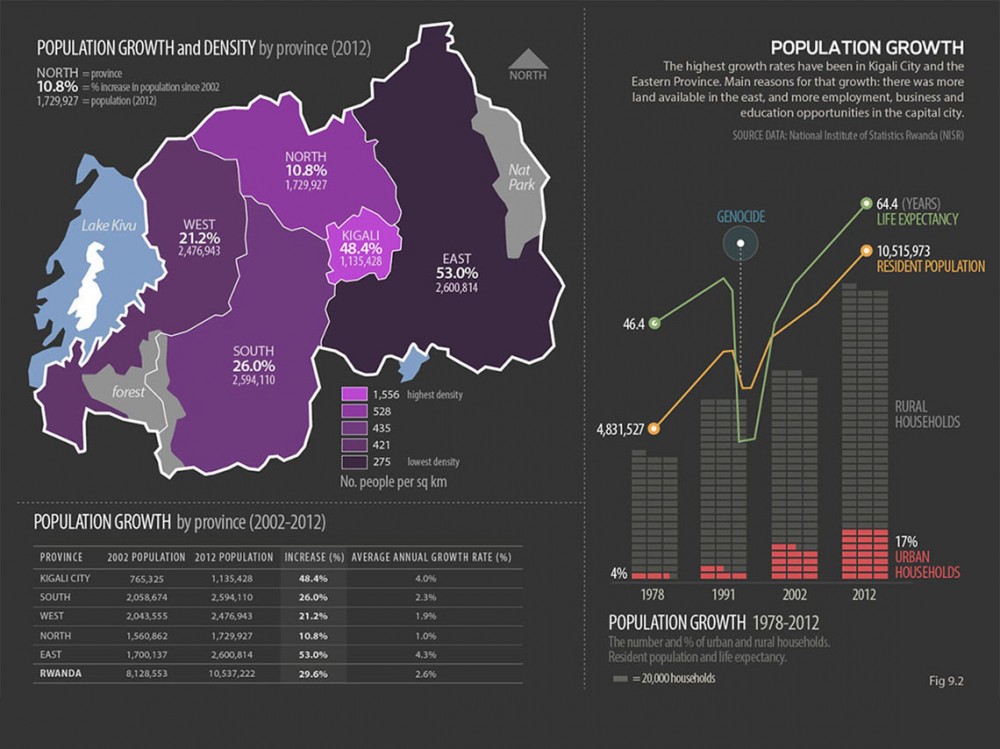Twenty-one years after the 1994 genocide, Rwandans are creatively shaping a society and country that is uniquely their own.
Using beautifully presented data, stories and photography, Rwanda Dreaming looks at the practicalities of re-building human wellbeing after conflict. It explores Rwanda’s solutions in justice, health, education, poverty, social cohesion and the environment.

A comprehensive look at Rwanda today

Why look at Rwanda?

SLIDE-OUT TABS with individual and group activities

Connecting statistics with real people

Engaging and creative data

Beautifully presented information
Written for Australian Year 10 Geography
The Education Edition includes a wide range of individual and group student activities.
It’s aimed at senior secondary students and has been written to fit well with the Australian Year 10 Geography curriculum (Human Wellbeing unit). It includes regional comparisons with Australia, especially indigenous Australia, and post-genocide Cambodia.
In stable societies, human wellbeing can be a fuzzy concept. By using the case study of a country forced to re-build from scratch, Rwanda Dreaming shows how dynamic the elements of human wellbeing can be in people’s lives. Rwanda’s young, engaged and forward-looking population will encourage students to think creatively about their own human environments and the possibilities for equitable and sustainable development on our shared planet.
Download a free sample in ePub3 format.
Download a free sample in interactive PDF format.
The Standard Edition includes exactly the same content, except for the student activities.
Chapters
Ch.1 WHAT IS HUMAN WELLBEING? An introduction
- Why look at Rwanda? Restoring wellbeing after conflict
- What is human wellbeing?
- Measuring human wellbeing. Why measure it? How?
- Other ways to measure wellbeing: multi-dimensional poverty, MDGs
- Wellbeing global and local: Rwanda, Cambodia and indigenous Australia
- Ethics: the lives behind the numbers
- Rwanda’s journey to human wellbeing
Ch.2 STRONG AND HEALTHY: poverty and health
- What does poverty look like? Living on less that $1.25/day
- Things families buy in Rwanda; working around the home
- Things that affect poverty in Rwanda
- Local initiatives: widows and orphans, social enterprise
- Health care: access, maternal and child health, malaria
- HIV/AIDS: a success story. Water and sanitation, nutrition
- International comparisons: Cambodia and indigenous Australia
Ch.3 A PLACE TO CALL HOME: home and belonging
- A country where nobody was home
- Neighbourhood genocide: abandoning home
- Temporary home: refugee camps; afraid to go home
- Home and identity: a long history of conflict
- Refugees: returning home
- Managing refugees in Rwanda: two case studies
- The place of former refugees in Rwanda today
- International comparisons: Cambodia and indigenous Australia
Ch.4 SAFE, FUNCTIONAL AND FAIR: the rule of law
- A history of conflict: inequality, discrimination and violence
- Genocide
- Restoring law and order: justice for genocide crimes
- Gacaca: community justice
- Confronting the past
- The International Criminal Tribunal for Rwanda
- A new legal foundation: law reform and a new constitution
- After gacaca
- International comparisons: Cambodia and indigenous Australia
Ch.5 GROWING AND LEARNING: children and education
- Children in Rwanda: a young population; daily life
- The effects of the genocide on children; caring for children in the aftermath
- Talking to children about genocide
- Education in Rwanda: before the genocide; the effects of the genocide on education
- Restarting schools after genocide
- A typical primary school in 2002
- Local initiatives: Fruits of Hope school – educating the next generation
- Education in the community: literacy and school attendance; education for the future
- International comparisons: Cambodia and indigenous Australia
Ch.6 WOMEN AND GIRLS: gender equality and women in society
- Women and Rwanda’s reconstruction: Breaking open the culture
- Talking with Rwandan women: Justine Mbabazi, Laura Rurangwa and Annet Ikiiriza
- Changing gender roles
- Women in Rwanda: education, fertility, women in leadership
Ch.7 LIVING TOGETHER: social cohesion
- Introduction: us and them
- A long history of division
- Local initiatives: Ukuri Kuganze – practical reconciliation
- Creative home-grown strategies
- Ubudehe: working together – grassroots democracy
- Local initiatives: agriculture and reconciliation
- The future of reconciliation: the Rwandan Reconciliation Barometer
- Phil Clark: the reality of reconciliation
- The future of the past
- International comparison: Cambodia and Australia
Ch.8 ARTS AND CULTURE: music, dance, arts and ideas
- Our Rwanda: a heritage to be proud of
- Genocide and culture: words and ideas; music and genocide
- Rebuilding a culture: using the past to build something new
- Rwanda today: Rwandan culture in a global community; music, dance, design and fashion
- International comparisons: Cambodia and indigenous Australia
Ch.9 HABITAT: the natural and built environments
- Population
- Farming and agriculture: the backbone of the economy
- Housing: a housing crisis; a typical Rwandan home
- Urbanisation: services; planning for the future; land mapping
- Building heritage
- Energy: Bio-mass, electricity and solar
- Environment and conservation
- Climate change
- National parks and tourism
- International comparisons: Rwanda, Cambodia and Australia
Ch.10 NATIONAL AND GLOBAL: governance, trade and development
- Governance and leadership: rebuilding from ground zero;
- Vision 2020 – thinking big
- Democracy in Rwanda
- Dealing with corruption
- Engaging with the world: international aid and trade
- Contributing to the global community
- Development and technology: business, employment, transport
- International comparisons: Rwanda, Cambodia and Australia
To get your copy…
For Mac, iOS, Windows and Android
Individual copies for Mac, iPad, Windows or Android
Also available on the iBookstore
Individual copies for Mac, iPad, iOS only
School site licences
One year education site licences







